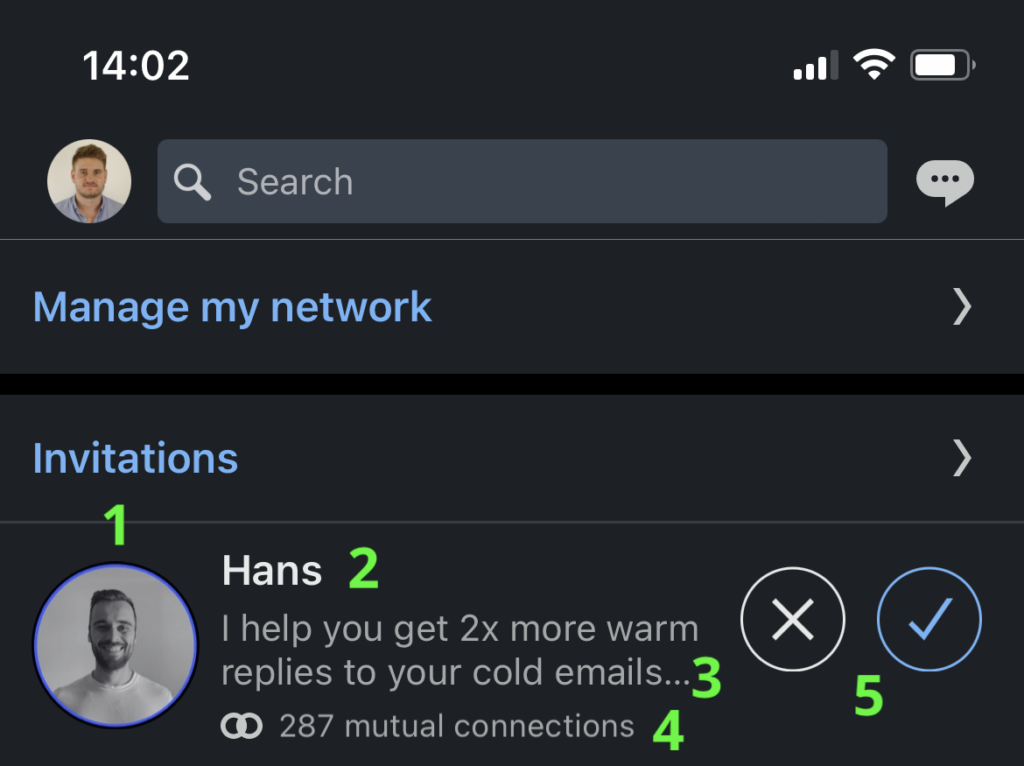In today’s newsletter, I’ll share my updated LinkedIn Connection Request Guide. LinkedIn connection requests are incredibly powerful for salespeople when used the right way. But most are using them to pitch slap their prospects, and they miss an opportunity to start real conversations.
Here’s how you can solve that, step-by-step:
Before sending a connection request, you need to make sure your LinkedIn profile is optimized for prospecting. A lot of profiles look like trophy shelves, or provide zero information on how they can help prospects solve important problems.
Here’s what you need:
Don’t miss this detailed guide to optimizing your LinkedIn profile.
Most people use LinkedIn on their mobile phones. There’s just one problem; 99% of salespeople prospect with their computers. Here’s what your connection requests look like on both formats:

Mobile view

Desktop view
As you can see, the request is composed of a few elements:
With that in mind, you need to optimize a few things.
First, your profile picture needs to be professional (simple, clear headshot, without distractions in the background). You also need to make sure everyone can see your picture in your visibility settings.
Second, you full name must be visible to everyone. Go to your visibility settings to make sure your full name is visible. Your headline also plays an important role in helping prospects identify if you can help them.
Having connections in common is a key factor in deciding to accept or ignore the connection request. The more people you have in common, the more likely you are to get accepted.
In most cases, prospects will decide to accept or ignore your request based on these 5 criteria, but sometimes they’ll dig into your LinkedIn profile, so make sure to check step 1 to optimize it.
If you can add a relevant note to your connection request, you’re more likely to get it accepted, and to receive answers from your prospects.
However, most people write platitudes in their connection request like “Saw we attended the same school” or “We are the leading provider of…”.
To avoid that, I always use a trigger. A trigger is a publicly available information that indicates someone may have a problem you can solve, or an interest in chatting with you.
Here is a list of triggers I use regularly:

When you have found your trigger, you can insert it in your connection request. This will give additional context to your prospects and help them decide if they should accept or ignore your invitation.
Here’s a simple framework you can use to insert the trigger you have found in your connection request:
With this simple framework, you stay under 300 characters (the limit for a connection request note), and you increase your chances of starting a conversation when your prospects accept a request.
Sometimes you may not have a relevant trigger to use in your connection request note. If that’s the case, do not add anything.
When you add a note to your connection request, you add more mental work for your prospects to determine what to do with the request. If the note is ultra-relevant and personalized, you’ll increase your acceptance rate. If it’s slightly generic, your acceptance rate will sink.
The golden rule of LinkedIn connection requests it: If you don’t have anything relevant to say, don’t say anything.
And these are the 3 steps you need to keep in mind as you send connection requests on LinkedIn in 2025. Optimize your profile as a landing page, understand the process, and decide when to add a note.
Hope this helps.
Cheers,
Thibaut Souyris
P.S. When you’re ready, here are 3 ways I can help you:
Get my free, 4 min weekly newsletter. Used by 5.900+ salespeople to book more meetings and work when, where, and how they want.
Get my free, 4 min weekly newsletter. Used by 5.900+ salespeople to book more meetings and work when, where, and how they want.
I will never spam you, or sell your info.
Get each episode in your mailbox when they release. Grab special discounts and offers.